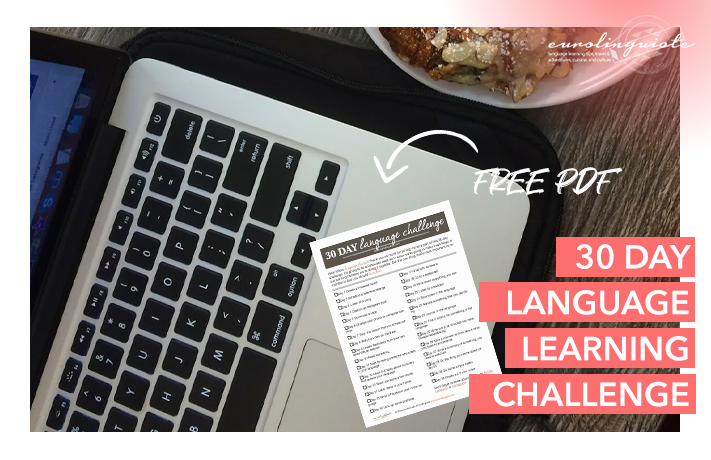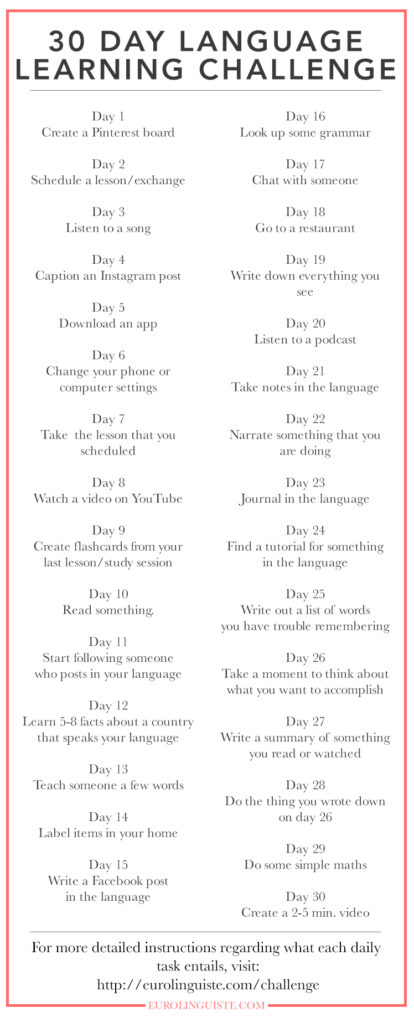30 Day Language Learning Challenge

My name is Shannon Kennedy and I'm the language lover,…
There are a ton of language challenges out there, so I thought it would be fun to get in on the game and start a 30 day language learning challenge.
I recently started the Fi3M Bootcamp (well, fairly recently) and I thought that this could be a fun way to boost my Croatian and make sure that I’m doing it every day. But I didn’t want to do it alone, so I hope you’ll join me. That way, we can cheer one another on. Plus, it’s an enjoyable way to stay engaged with your language. We’re starting November 1st!

Without further ado, here are the daily tasks to complete this challenge.

30 Day Language Learning Challenge
Day 1 – Create a Pinterest board with some of your favorite language articles or learning websites.
You can follow me if you need a bit of inspiration or a place to start. I have boards you can “steal” articles from for each of the languages I am studying or have studied.
Day 2 – Schedule a lesson or language exchange with someone.
Not sure where to find a tutor or exchange partner? Baselang, iTalki, Lingoda, Verbling, E-Chinese Learning, et al. are all great options.
Day 3 – Listen to song and read along with lyrics – see how much you can work out.
If you’re up for a bit of a bonus, you can sit down and work on translating the lyrics into your native language.
Day 4 – Caption your next instagram post in your target language.
Bonus points if you even come up with hashtags that are used by Instagrammers who speak your target language.
Day 5 – Make sure you have at least one app on your phone that you can use daily.
My personal faves are Memrise, LingQ and HelloTalk.
Day 6 – Change your phone or computer language settings.
It’s funny how suddenly “needing” to figure out what words mean (I mean, how else are you going to use your device?!) leads to you learning them.
Day 7 – Take that lesson you scheduled.
You can do it! And it’s going to be great.
Day 8 – Watch a video on YouTube.
This can be a lesson or native video content – whichever is best suited to your level.
Day 9 – Create flashcards from the new words from your last lesson/study session.
This is something that I’ve started doing in the past few months (via Memrise) and it’s done wonders for me actually remembering the words and phrases I need to know.
Day 10 – Read something.
Anything! You can even join us as a part of the Language Reading Challenge if you’d like. Acceptable reading materials include: a magazine, news article, part of a book, an entire book, a comic, instructions to a video game, the back of the shampoo bottle, whatever.
Day 11 – Start following an Instagram or Twitter account for someone who writes in your language.
An easy way to find them is by deciding on a word or phrase (in your target language) and searching for it as a hashtag.
Day 12 – Learn five to eight facts about a country that speaks your language.
Bonus if you do this using the Wikipedia page for your country in your target language.
Day 13 – Teach someone a few words in the language.
It can be anyone who’s patient enough to let you do this – a friend, family member or co-worker. The point is to teach. It’s a great way to instill the information you’re learning.
Day 14 – Label the items in your home.
Or in just one part of your home. Sticky notes are the most socially acceptable way to do this. Don’t write on your roommates’ or parents’ things with Sharpie. They probably wouldn’t appreciate it as much as one might hope.
Day 15 – Write a FB post in your language.
Doesn’t matter if your friends don’t understand! Besides, that’s what that fancy little “translate” button is anyway. For them – not for you. Write your own post as best you can!
Day 16 – Look up something about the grammar that’s holding you back.
For me that’s usually, in some way, related to cases.
Day 17 – Chat with someone in your language.
You can do this through a group on social media, HelloTalk or even through the messaging feature on iTalki.
Day 18 – Go to a restaurant that serves food from a country that speaks your language.
See if anyone who works there speaks it. And if they do, try to order in the language.
Day 19 – Write down everything you can see wherever you are at this moment (in your target language, of course).
For example, at this moment, I’m at my desk so I see:
* a mess
* a calculator
* a cup of coffee
* a phone
* a laptop
* a monitor
* a bunch of papers
* two highlighters
* a tube of lip gloss
* some cables
* a pen
* a stapler
* pictures of Little Linguist
* a note about something important taped to my monitor
Now that I have my list, I can work out what the words are in my language.
Day 20 – Listen to a podcast.
Again, it’s okay if this is a language lesson or native content.
Day 21 – Take notes in your language (a work meeting, class session, grocery list or to-do list).
If you’re still a beginner, do this with something simple (and maybe not super important). If you’re more advanced – challenge yourself. But also, don’t forget to buy the toothpaste just because you couldn’t think of the word in your language. Or that important project that was assigned to you at school or work.
Day 22 – Narrate something that you’re doing in your target language.
It can be the recipe for a meal you’re making, the chores you’re doing or whatever work task you’re doing.
Day 23 – Journal in your language.
It can be about anything. The weather, your routine, how much fun this challenge is or how bad Shannon’s sense of humor is. Anything goes, really.
Day 24 – Find a tutorial for something that you enjoy doing in your language.
It can be written or video. Some ideas to give you inspiration: a technology-related tutorial, martial arts, yoga, any other sport, a recipe, bookmaking, crafting of any sort, sewing, crocheting, or even video game walkthroughs.
Day 25 – Write out a list of vocabulary words you have trouble remembering by hand.
Sometimes this manual process does a lot for retention.
Day 26 – Take a moment to think about exactly what you hope to accomplish by learning your language.
Some inspiration:
* What will you be able to do when you speak your language that you couldn’t do before?
* What’s one thing you wish you could say in your target language that you can’t today?
* What one thing about the language will be a huge relief once you finally understand it?
Write down what you hope to accomplish and then take another moment to think of one thing that you can do THIS WEEK to help you step towards getting there.
Day 27 – Try to write a summary of the thing you read or watched earlier in the challenge in your target language.
It can be the YouTube video, the podcast or whatever it was that you read.
Day 28 – That one thing you wrote down, today’s the day to do it.
On Day 26, you wrote down one thing you could do that will help you step towards your ultimate goal. Whatever that thing was, today’s the day you’re going to do it (or start doing it).
Day 29 – Do some simple maths.
Any time you do any sort of math today (tallying up a price, use a calculator, or talk about numbers in general), try to do it in your target language. It’s okay to do it in your head or a whisper if it’s not the appropriate situation to do it out loud. Numbers are always a challenge in a foreign language because they’re one of the things we need to translate in our heads the longest. Start trying to train yourself out of this today! (Here’s a fun app I recently discovered that helps with numbers)
Day 30 – Create a video around 2-5 minutes in length of you speaking your language.
It’s okay if you read a script. Do whatever feels right for your level. Share it on Facebook or YouTube.
And that’s it! Congrats on making it through all 30 days.
Don’t forget to download the printable version of this challenge (and don’t feel bad if you do it out of order – that’s okay).

If you do the challenge, I’d love for you to share your progress with me. Feel free to tag me in your posts about it on Twitter (@eurolinguistesk) or Facebook and Instagram (@eurolinguiste). I look forward to seeing your progress.
PS. If you have any suggestions for activities for different days, I’d love to hear about them in the comments below. This may be something I host again but with different daily tasks!
My name is Shannon Kennedy and I'm the language lover, traveler, and foodie behind Eurolinguiste. I'm also the Head Coach of the Fluent in 3 Months Bootcamp, co-founder of Women in Language, and former Resident Polyglot at Drops.



